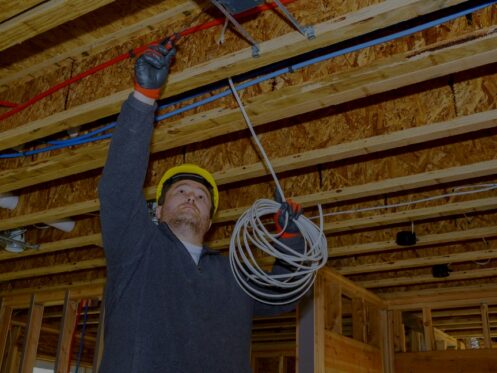Updated July 24, 2024
Although the terms breaker box and electrical panel are often used interchangeably, they’re two very different things. They perform two distinctly different jobs, and they exhibit problems in different ways. Knowing what each is and how it works is an important part of managing and maintaining your Charlotte, NC home.
Breaker Boxes: What They Are and What They Do
At one time, all homes had fuse boxes. When electrical overloads occurred, homeowners had to make their way to fuse boxes in darkness to find and replace one or more blown fuses. Worse still, these boxes were often located outdoors, in basements, or in other remote and inconvenient areas.
Also known as circuit breakers or circuit breaker boxes, breaker boxes have replaced this outdated setup. If you’ve tripped a breaker in your home before, then you’ve already visited your breaker box to turn the power to the affected area back on. The breaker box is where you go to turn an appliance completely off before troubleshooting or repairing it, or to restore the flow of electricity after a power surge or recently resolved outage.
Breaker boxes or circuit breaker boxes control the flow of electricity throughout your home. When too much electricity flows through any breaker, it opens and immediately stops the flow. For instance, if your television, gaming system, computer, and several lamps are on in your living room, turning a portable window air conditioner on could cause the breaker to trip and disconnect the power. This is a sign that the electrical load for this space is higher than this portion of your electrical system can handle.
Breaker boxes have individual breakers for each room or area throughout the building that can be toggled off and on or reset as needed. Every circuit breaker box also has a main switch that can shut off all power to the home at once. Frequently referred to as the “breaker main” or “main breaker,” it offers a quick and easy way to mitigate an unknown electrical problem.
What Your Electrical Panel Is
Unlike the breaker boxes that homeowners regularly open and use, electrical panels function behind the scenes, and they aren’t to be tampered with by anyone but a licensed electrician. Significantly larger than breaker boxes, electrical panels have multiple breakers. These panels serve as the hub for all electrical wiring throughout the building. Also known as load centers, electrical panels distribute currents to different circuits in your home from your utility company’s power supply. In comparison, circuit breakers simply ensure that all circuits are protected from power surges, short circuits, and other like issues.
Signs of Problems at the Electrical Panel
Electrical panels can last between 30 and 50 years. However, throughout this time, significant changes in appliances and devices and dramatic increases in household energy demand could make replacement essential. If your home is just 20 years old and has the same electrical panel that was installed at its initial construction, it could struggle to handle the distribution of your electrical load when all of your electronics are plugged in and turned on. The best way to accurately determine the right time for a panel replacement is by having your home’s wiring assessed by a licensed electrician.
However, there are a few strong indicators of electrical panel problems. These include:
- Burns or scorch marks at the interior of the panel where the breaker connects
- Melting or fishy-smelling wires
- Lights that constantly dim and flicker
- Rust or other corrosion on or around the electrical panel or its wiring
If you intend to add a new high-powered appliance to your home or if your panel still uses fuses rather than breakers for overload protection, now is a good time to have your panel replaced. Keeping your electrical panel up to date and in optimal condition will greatly minimize your risk of electrical fires.
Common Breaker Box Issues and Their Symptoms
Common signs of breaker box problems include breakers that frequently trip, burning smells coming directly from breaker boxes, and burn marks on or in the breaker box itself. Depending upon the location of your breaker box, you might also notice moisture or mold at its interior, evidence of pests, or rust. When homes have high relative humidity levels or indoor humidity of 50% or higher, both breaker boxes and electrical panels can become coated in condensation.
Birds, rodents, and other small-sized pests are more likely to target breaker boxes that are installed outside of homes given their warmth and relatively easy access. Over the past two decades, an increasing number of municipalities have updated their building codes to require the outdoor installation of breaker boxes. Having breaker boxes outside makes it easier for firefighters and other first responders to shut the electricity off when responding to fires or other dangerous events.
We make it easy for residents of Charlotte, North Carolina to maintain and protect their homes. In addition to helping our clients make informed decisions about their electrical systems, we offer electrical inspections, electrical panel upgrades, and whole-home rewiring services. We also provide heater and air conditioner installation, maintenance, and repair services. To find out about our preventative maintenance plans or to schedule an appointment, contact Putnam Mechanical now!
